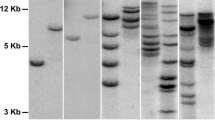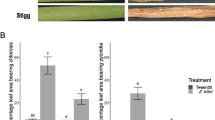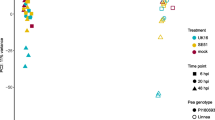Abstract
To date, several dozen plant disease resistance genes have been cloned from a variety of species. Despite successful efforts to isolate functional disease resistance genes and understand their roles in defence responses, surprisingly little is known about their transcriptional regulation. Global climate changes are expected to impact crop plant production, plant physiology and plant-microbe interactions. Understanding the impact of varying environmental and physiological factors on disease resistance gene transcript levels may be key to successful deployment. In this study we analyzed the expression patterns of the Phytophthora infestans resistance gene RB in transgenic potato plants across a broad range of temperatures and key physiological stages. Our results demonstrate that while temperature extremes have an obvious effect on plant morphology and development, RB is transcribed at all ages and temperatures in all genetic backgrounds. Quantitative analyses demonstrate that the RB transcript accumulates comparably throughout plant development, including at the tuber initiation stage. Implications for successful deployment of RB are discussed.



Similar content being viewed by others
Abbreviations
- NBS-LRR:
-
Nucleotide binding site-leucine rich repeat
- R gene:
-
Resistance gene
- RT-PCR:
-
Reverse transcription-polymerase chain reaction
References
Bradeen, J. M., Carputo, D., & Douches, D. S. (2008). Potato. In C. Kole & T. C. Hall (Eds.), A compendium of transgenic crop plants: Transgenic sugar, tuber and fiber crops (pp. 117–156). Oxford: Blackwell.
Bradeen, J. M., Iorizzo, M., Mollov, D. S., Raasch, J., Kramer, L. C., Millett, B. P., et al. (2009). Higher copy numbers of the potato RB transgene correspond to enhanced transcript and late blight resistance levels. Molecular Plant-Microbe Interactions, 22, 437–446.
Caicedo, A. L., & Schaal, B. A. (2004). Heterogeneous evolutionary processes affect R gene diversity in natural populations of Solanum pimpinellifolium. Proceedings of the National Academy of Sciences, 101, 17444–17449.
Cannon, S. B., Zhu, H., Baumgarten, A. M., Spangler, R., May, G., Cook, D. R., et al. (2002). Diversity, distribution, and ancient taxonomic relationships within the TIR and non-TIR NBS-LRR resistance gene subfamilies. Journal of Molecular Evolution, 54, 548–562.
Cao, Y., Ding, X., Cai, M., Zhao, J., Lin, Y., Li, X., et al. (2007). The expression pattern of a rice disease resistance gene Xa3/Xa26 is differentially regulated by the genetic backgrounds and developmental stages that influences its function. Genetics, 177, 523–533.
Century, K. S., Lagman, R. A., Adkisson, M., Morlan, J., Tobias, R., Schwartz, K., et al. (1999). Developmental control of Xa21-mediated disease resistance in rice. The Plant Journal, 20, 231–236.
Coakley, S. M., Scherm, H., & Chakraborty, S. (1999). Climate change and plant disease management. Annual Review of Phytopathology, 37, 399–426.
Couch, B. C., Spangler, R., Ramos, C., & May, G. (2006). Pervasive purifying selection characterizes the evolution of I2 homologs. Molecular Plant-Microbe Interactions, 19, 288–303.
Crosier, W. (1934). Studies in the biology of Phytophthora infestans (Mont) de Bary. Ithaca: Cornell University Agricultural Experiment Station.
Daolin, F., Uauy, C., Dsistelfeld, A., Blechl, A., Epstein, L., Chen, X., et al. (2009). A kinase-START gene confers temperature-dependent resistance to wheat stripe rust. Science, 323, 1357–1360.
De Ilarduya, O. M., & Kaloshian, I. (2001). Mi-1.2 transcripts accumulate ubiquitously in resistant Lycopersicum esculentum. Journal of Nematology, 33, 116–120.
Garrett, K. A., Dendy, S. P., Frank, E. E., Rouse, M. N., & Travers, S. E. (2006). Climate change effect on plant disease: genomes to ecosystems. Annual Review of Phytopathology, 44, 489–509.
Goggin, F. L., Shah, G., Williamson, V. M., & Ullman, D. E. (2004). Developmental regulation of Mi-mediated aphid resistance is independent of Mi-1.2 transcript levels. Molecular Plant-Microbe Interactions, 17, 532–536.
Hijmans, R. J. (2003). The effect of climate change on global potato production. American Journal of Potato Research, 80, 271–280.
Huang, S., van der Vossen, E. A. G., Kuang, H., Vleeshouwers, V. G. A. A., Zhang, N., Borm, T. J., et al. (2005). Comparative genomics enabled the isolation of the R3a late blight resistance gene in potato. The Plant Journal, 42, 251–261.
Innes, R. W. (2004). Guarding the goods: new insights into the central alarm system of plants. Plant Physiology, 135, 695–701.
Kramer, L. C., Choudoir, M. J., Wielgus, S. M., Bhaskar, P. B., & Jiang, J. (2009). Correlation between transcript abundance of the RB gene and the level of the RB-mediated late blight resistance in potato. Molecular Plant-Microbe Interactions, 22, 447–455.
Levy, D., & Veilleux, R. E. (2007). Adaption of potato to high temperature and salinity-a review. American Journal of Potato Research, 84, 487–506.
Lokossou, A. A., Park, T., van Arkel, G., Arens, M., Ruyter-Spira, C., Morales, J., et al. (2009). Exploiting knowledge of R/Avr genes to rapidly clone a new LZ-NBS-LRR family of late blight resistance genes from potato linkage group IV. Molecular Plant-Microbe Interactions, 22, 630–641.
Martin, G. B., Bogdanove, A. J., & Sessa, G. (2003). Understanding the functions of plant disease resistance proteins. Annual Review of Plant Biology, 54, 23–61.
McDowell, J. M., & Simon, S. A. (2006). Recent insights into R gene evolution. Molecular Plant Pathology, 7, 437–448.
Melhus, I. E. (1915). Germination and infection with the fungus of the late blight of potato (Phytophthora infestans). Madison: University of Wisconsin Agricultural Experiment Station.
Mes, J. J., van Doorn, A. A., Wijbrandi, J., Simons, G., Cornelissen, B. J. C., & Haring, M. A. (2000). Expression of the Fusarium resistance gene I-2 colocalizes with the site of fungal containment. The Plant Journal, 23, 183–193.
Meyers, B. C., Kozik, A., Griego, A., Kuang, H., & Michelmore, R. W. (2003). Genome-wide analysis of NBS-LRR-encoding genes in Arabidopsis. The Plant Cell, 15, 809–834.
Meyers, B. C., Kaushik, S., & Nandety, R. S. (2005). Evolving disease resistance genes. Current Opinion in Plant Biology, 8, 129–134.
Millett, B. P., & Bradeen, J. M. (2007). Development of allele-specific PCR and RT-PCR assays for clustered resistance genes using a potato late blight resistance transgene as a model. Theoretical and Applied Genetics, 114, 501–513.
Millett, B. P., Mollov, D. S., Iorizzo, M., Carputo, D., & Bradeen, J. M. (2009). Changes in disease resistance phenotypes associated with plant physiological age are not caused by variation in R gene transcript abundance. Molecular Plant-Microbe Interactions, 22, 362–368.
Nicot, N., Hausman, J.-F., Hoffmann, L., & Evers, D. (2005). Housekeeping gene selection for real-time RT-PCR normalization in potato during biotic and abiotic stress. Journal of Experimental Botany, 56, 2907–2914.
Pan, Q., Wendel, J., & Fluhr, R. (2000). Divergent evolution of plant NBS-LRR resistance gene homologues in dicot and cereal genomes. Journal of Molecular Evolution, 50, 203–213.
Park, T. H., Gros, J., Sikkema, A., Vleeshouwers, V. G. A. A., Muskens, M., Allefs, S., et al. (2005). The late blight resistance locus Rpi-blb3 from Solanum bulbocastanum belongs to a major late blight R gene cluster on chromosome 4 of potato. Molecular Plant-Microbe Interactions, 18, 722–729.
Ribeiro, O. K. (1983). Physiology of asexual sporulation and spore germination in Phytophthora. In D. C. Erwin, S. Bartnicki-Garcia, & P. H. Tsao (Eds.), Phytophthora, its biology, taxonomy, ecology, and pathology. St. Paul: APS.
Rubio-Covarrubias, O. A., Douches, D. S., Hammerschmidt, R., da Rocha, A., & Kirk, W. W. (2006). Effect of photoperiod and temperature on resistance against Phytophthora infestans in susceptible and resistant potato cultivars: effect on deposition of structural phenolics on the cell wall and resistance to penetration. American Journal of Potato Research, 83, 325–334.
Sato, N. (1994). Effect of sporulating temperature on the limit temperature of indirect germination of the sporangia of Phytophthora infestans. Annals of the Phytopathological Society of Japan, 60, 60–65.
Scheideler, M., Schlaich, N. L., Fellenberg, K., Beissbarth, T., Hauser, N. C., Vingron, M., et al. (2002). Monitoring the switch from housekeeping to pathogen defense metabolism in Arabidopsis thaliana using cDNA arrays. The Journal of Biological Chemistry, 277, 10555–10561.
Schornack, S., Peter, K., Bonas, U., & Lahaye, T. (2005). Expression level of avrBs3-like genes affect recognition specificity in tomato Bs4- but not in pepper Bs3- mediated perception. Molecular Plant-Microbe Interactions, 18, 1215–1225.
Silvar, C., Merino, F., & Diaz, J. (2007). Differential activation of defense-related genes in susceptible and resistant pepper cultivars infected with Phytophthora capsici. Journal of Plant Physiology, 165, 1120–1124.
Song, J., Bradeen, J. M., Naess, S. K., Raasch, J. A., Wielgus, S. M., Haberlach, G. T., et al. (2003). Gene RB from Solanum bulbocastanum confers broad spectrum resistance to potato late blight. Proceedings of the National Academy of Sciences, 100, 9128–9133.
Trindade, L. M., Horvath, B. M., van Berloo, R., & Visser, R. G. F. (2003). Analysis of genes differentially expressed during potato tuber life cycle and isolation of their promoter regions. Plant Science, 166, 423–433.
van der Vossen, E. A. G., Sikkema, A., Hekkert, B. T. L., Gros, J., Stevens, P., Muskens, M., et al. (2003). An ancient R gene from the wild potato species Solanum bulbocastanum confers broad-spectrum resistance to Phytophthora infestans in cultivated potato and tomato. The Plant Journal, 36, 867–882.
van der Vossen, E. A. G., Gros, J., Sikkema, A., Muskens, M., Wouters, D., Wolters, P., et al. (2005). The Rpi-blb2 gene from Solanum bulbocastanum is an Mi-1 gene homolog conferring broad-spectrum late blight resistance in potato. The Plant Journal, 44, 208–222.
Wang, Y., Bao, Z., Zhu, Y., & Hua, J. (2009). Analysis of temperature modulation of plant defense against biotrophic microbes. Molecular Plant-Microbe Interactions, 22, 498–506.
Whitham, S., Dinesh-Kumar, S. P., Choi, D., Hehl, R., Corr, C., & Baker, B. (1994). The product of the tobacco mosaic virus resistance gene N: similarity to toll and the interleukin-1 receptor. Cell, 78, 1101–1115.
Xiao, S., Brown, S., Patrick, E., Brearley, C., & Turner, J. G. (2003). Enhanced transcription of the Arabidopsis disease resistance genes RPW8.1 and RPW8.2 via a salicylic acid-dependent amplification circuit is required for hypersensitive cell death. The Plant Cell, 15, 33–45.
Yang, S., & Hua, J. (2004). A haplotype-specific resistance gene regulated by BONZAI1 mediates temperature-dependent growth control in Arabidopsis. The Plant Cell, 16, 1060–1071.
Zhou, T., Wang, Y., Chen, J. Q., Araki, H., Jing, Z., Jiang, K., et al. (2004). Genome-wide identification of NBS genes in japonica rice reveals significant expansion of divergent non-TIR NBS-LRR genes. Molecular Genetics and Genomics, 271, 402–415.
Acknowledgements
Funding for this project was provided by the Grant-in-Aid program of the University of Minnesota Graduate School and by the Minnesota Area II Potato Growers Research and Promotion Council. The authors gratefully acknowledge computer resources provided by the Minnesota Supercomputing Institute. This is contribution #234 from the Department of Soil, Plant, Environmental and Animal Production Sciences, University of Naples Federico II.
Author information
Authors and Affiliations
Corresponding author
Rights and permissions
About this article
Cite this article
Iorizzo, M., Mollov, D.S., Carputo, D. et al. Disease resistance gene transcription in transgenic potato is unaltered by temperature extremes and plant physiological age. Eur J Plant Pathol 130, 469–476 (2011). https://doi.org/10.1007/s10658-011-9765-7
Accepted:
Published:
Issue Date:
DOI: https://doi.org/10.1007/s10658-011-9765-7




